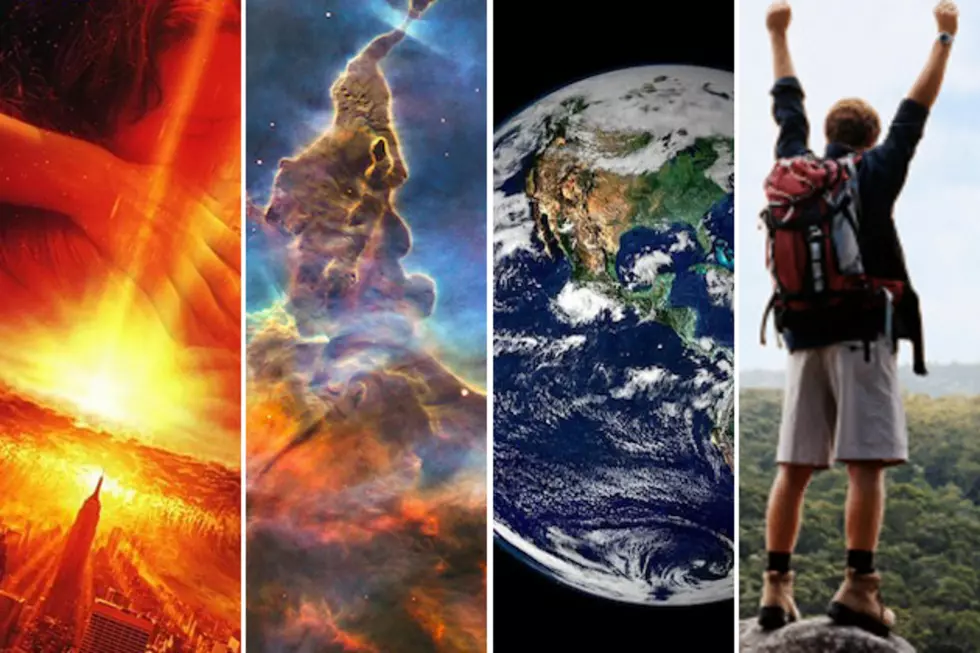
10 Amazing Facts About the Universe You Won’t Believe
The universe is a pretty amazing place, from the unimaginably large, right down to the incredibly small. There’s an awful lot going on in this field we call "existence."With the recent discovery of what is most likely the elusive Higgs boson particle, or some variant thereof, by scientist's working at the Large Hadron Collider near Geneva, there’s a lot of buzz surrounding information having to do with the fabric of the universe. The standard model of theoretical physics says the Higgs boson particle is responsible for all the mass in the universe, which is a heck of a lot of matter.
Let’s take a look at some of this awe-inspiring matter now, as well as a look at the Higgs boson particle, and see how we fit inside the intricate patterns that make up everything.
Even When You’re Standing Still, You’re Still Moving
A human body, or any object on the Earth, is never at rest. Even when you’re asleep in bed, you’re moving pretty fast. Our Milky Way Galaxy is rotating at 225 kilometers per second, and hurling through the cosmos at an estimated 305 kilometers per second. Add those figures together, and we’re racing through space at around 530 kilometers, or 330 miles per second. So in one minute’s time, you’ve traveled almost 20,000 kilometers, or more than 12,000 miles. And your friends always complain that you never go anywhere.
There Are at Least 10 Billion Trillion Stars in the Universe
That’s a very big number. When you really think about it, 10 billion trillion stars makes the cult of sun worship seem a little obsolete, although our star, the sun, is very important to us. Without it, life on earth wouldn’t be possible.
Let’s put 10 billion trillion stars into perspective, shall we? For those of you who know a bit of math, that would be 10 to the power of 22 stars, or written out, it would be 10,000,000,000,000,000,000,000. There are probably more stars in existence than grains of sand on all of the world’s beaches. If only 1% of those stars had Earth-like planets, the universe would literally be teeming with life.
An Asteroid Might Hit The Earth in 2029
This didn't exactly end well.
The greatest chance so far, according to astronomers, of a large asteroid colliding with the earth and wiping life out is in 2029. Asteroids have hit the planet before, and caused mass extinctions, so there is some precedent for it happening again.
The culprit this time is the Apophis Asteroid (99942 Apophis), which is headed our way in 2029. There’s a little less than a 3% chance that this bad boy will crash into terra firma. Let’s hope Apophis gives the planet a miss, otherwise you can stop paying into your retirement account right now.
Neutron Stars Are Very, Very Heavy
What exactly is a neutron star, you might be wondering? Well, neutron stars are the densest object known in the universe. They are created inside large stars during a supernova explosion. When the core of the star collapses, electron and proton pairs get crushed down into neutrons.
While neutron stars are only about 10-13 miles in diameter, they are heavier than many stars. A thimbleful, or sugar cube, amount of a neutron star weighs around 100 million tons. That’s more than a large mountain.
We Are Made Out of Stars
That explains all the glitter GIFs.
Human beings are literally made out of star stuff. Almost all of the chemical elements that make up a person come from the stars. Any element heavier than hydrogen originated in the stars, and we are definitely composed of more than hydrogen.
Calcium, carbon, hydrogen, nitrogen, oxygen and around 60 other basic ingredients make up a human being. Since hydrogen and helium were the only elements around before the stars "cooked" up some more, it’s a safe bet that most of the substance that constitutes the "physical" you comes from the stars.
One Million Earths Could Fit Inside The Sun
Even though there are a lot of stars out there, none is more important to us than our own sun. When compared to other stars, it’s fairly small, classified as a G2 dwarf star. But that doesn’t mean we're complaining. Approximately one million Earths could fit inside this dwarf star. It might not be the largest star in the universe, but it gets the job done as far as sustaining life on Earth goes.
The Higgs Boson Particle Gives Form to the Universe
There has been a lot of hoopla surrounding the discovery of the mysterious Higgs boson particle. We already took a brief look at it in the introduction to this article, but let’s dive in a little bit deeper.
The Higgs boson, if the standard theory proves correct, is the heaviest element in existence (as far as we know). This cosmic "molasses" weighs down the tiny particles that make up atoms, giving them substance. Without the Higgs boson, the universe would most likely be a kind of cosmic "soup" where particles zip around, absent any substantial form. The discovery of the Higgs boson particle is to physics what Darwin's theory of evolution was to biology. That means it's a very big deal.
The Biggest Mountain in Our Solar System Is on Mars
Nice try, jerk.
Sorry Mount Everest -- you’re not the king of the solar system. That honor belongs to Olympus Mons, a massive mountain on our planetary neighbor, Mars. Olympus Mons is a giant mound of red dirt and rock. This volcanic behemoth is 2,400 meters, or 80,000 feet tall, which makes it almost 15 miles high. Everest is a mere dwarf in comparison. This giant Martian volcano is either a mountain climber’s wildest dream, or worst nightmare.
Our Galaxy Is on a Collision Course with the Andromeda Galaxy
The Milky Way Galaxy, which is to say our very own galaxy, is on a collision course with our nearest neighbor, the Andromeda Galaxy. Even though these two conglomerations of stars are destined to smash together, you shouldn’t lose any sleep over the incident. The impending impact won’t happen for another 3 billion years. The chances of you being around for that galactic "fender bender" are pretty slim, unless you're planning to cryogenically freeze yourself or something.
The Earth Is Billions of Years Old
Our planet has been around for quite some time. It’s been around, in fact, for about 4.54 billion years, give or take 0.02 billion years. Life has only been on the planet for a short amount of time, but the variety of life that has crawled, slithered, swam and trod upon the planet is pretty spectacular -- from single celled organisms, to giant sharks and snakes, to dinosaurs, to mammals. If that comet coming in 2029 (and again, in 2036) misses the planet, hopefully we’ll thrive here for a long time to come.



